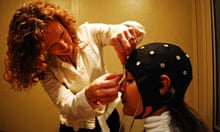Getting more kids to code has been a cause célèbre for the technology industry for some time. Teaching programming skills to children is seen as a long-term solution to the “skills gap” between the number of technology jobs and the people qualified to fill them.
From this month, the UK is the guinea pig for the most ambitious attempt yet to get kids coding, with changes to the national curriculum. ICT – Information and Communications Technology – is out, replaced by a new “computing” curriculum including coding lessons for children as young as five.
This has been coming for a while: the new curriculum was published in September 2013 to fanfare within the technology industry. But it seems many parents will be surprised when their children come home from school talking about algorithms, debugging and Boolean logic.
A survey of 1,020 parents of 5-18 year-olds in England commissioned by BCS, the Chartered Institute for IT, found that 60% were unaware or unsure about the changes to the curriculum. Similar surveys by tech firms O2 and Ocado Technology yielded similar results: 64% and 65% of parents (respectively) who were unaware of the changes.
If you’re one of those parents, here’s a guide to what your children will be studying under the new computing curriculum; why there is more of an emphasis on programming skills; how teachers have been preparing for the changes; and how you can support your children and their schools over the coming months.
Why is this happening?
The shakeup of computer studies in schools has been trailed for a while, after criticism from ministers and technology companies of the existing ICT curriculum. The education secretary (at the time), Michael Gove, outlined the political rationale for the changes in a speech this January:
“ICT used to focus purely on computer literacy – teaching pupils, over and over again, how to word-process, how to work a spreadsheet, how to use programs already creaking into obsolescence; about as much use as teaching children to send a telex or travel in a zeppelin.
Our new curriculum teaches children computer science, information technology and digital literacy: teaching them how to code,and how to create their own programs; not just how to work a computer, but how a computer works and how to make it work for you.”
This plays directly in to the complaints of technology companies that the UK has not been producing enough graduates qualified to fill vacancies. Microsoft and Google, along with BCS and its Computing at School working group, and the Royal Academy of Engineering were all involved in the new curriculum.
There is more to this than jobs, though. Campaigners argue that learning programming skills will benefit children in other ways whatever their ultimate career – almost akin to the reasoning for giving children the chance to learn a musical instrument or foreign language.
“We’re not just trying to encourage people to become developers. We’re trying to encourage children to become creative,” says Sophie Deen, head of Code Club Pro, which has been running training sessions for teachers this year.
“At primary level, it helps children to be articulate and think logically: when they start breaking down what’s happening, they can start predicting what’s going to happen. It’s about looking around you almost like an engineer at how things are constructed.”
“If you teach computing and do it right, you can help children develop their learning in literacy and numeracy,” says Bill Mitchell, director of education at BCS, citing children using the Scratch programming language to make animations for their creative writing, and suggesting that studying algorithms can help their understanding of sentence structure.
“To me, the basic idea of computing is you have to get a computer to solve a problem: you have to come up with an algorithm, a set of instructions. If you can do that, it’s a hugely valuable skill whenever you’re working as a team for any kind of project,” he says.
“Also, think about other subjects. When you learn physics, you think about physics. But when you learn computing, you are thinking about thinking. About how thinking works. You have to try to imagine how this computer is going to do something for you. There are lots of transferable skills.”
What will your child be learning?
There are three distinct stages for the new computing curriculum:
Key Stage 1 (5-6 year-olds): Children will be learning what algorithms are, which will not always involve computers. When explained as “a set of instructions” teachers may illustrate the idea using recipes, or by breaking down the steps of children’s morning routines. But they will also be creating and debugging simple programs of their own, developing logical reasoning skills and taking their first steps in using devices to “create, organise, store, manipulate and retrieve digital content”.
Key Stage 2 (7-11 year-olds): Slightly older primary-school children will be creating and debugging more complicated programs with specific goals and getting to grips with concepts including variables and “sequence, selection, and repetition in programs”. They will still be developing their logical reasoning skills and learning to use websites and other internet services. And there will be more practice at using devices for collecting, analysing and presenting back data and information.
Key Stage 3 (11-14 year-olds): Once children enter senior school they will be using two or more programming languages – “at least one of which is textual” – to create their own programs. Schools and teachers will be free to choose the specific languages and coding tools. Pupils will be learning simple Boolean logic (the AND, OR and NOT operators, for example), working with binary numbers, and studying how computer hardware and software work together.
At all these levels, children will also be studying computer and internet safety, including how to report concerns about “content or contact” online. The full breakdown of the changes can be found here.
How have teachers been preparing for this?
As with any major change to the curriculum, teachers will be at the sharp end of the syllabus. That includes tens of thousands of primary-school teachers who may be new to programming themselves being tasked with teaching it to their pupils.
There has been plenty of activity around trying to train teachers for this. The government announced £1.1m of funding for BCS in December 2013 to develop a programme for primary school teachers who are new to teaching computing, then a £500,000 fund in February 2014 to attract businesses to help train teachers.
You can see the kind of materials teachers have been getting by reading BCS’s two Computing in the National Curriculum guides, which have been sent to schools and published online in PDF form – one for primary teachers and one for secondary teachers.
Code Club took £100,000 of funding from Google to introduce its own training program in February, while Microsoft invested £334,000 in a partnership with Computing at School to run “Back to School” training sessions for teachers. Meanwhile, companies making apps or services that teach children to code have been releasing lesson guides and other teaching material.
There has been controversy around the involvement of private companies in training teachers: for example, Code Club director Linda Sandvik resigned earlier this month, saying she had been told not to criticise sponsors (eg Google) over issues like mass surveillance. In response Google said it did not order any such silence, while Code Club has published guidelines on its relationship with funders.
What can you do to support your child?
If you’ve got this far in the article, you’re no longer one of the 60%-plus of parents who do not know about the changes to England’s computing curriculum. That’s a decent start.
Talking to experts about what else parents can do, I found a common theme: simply be interested. Just as parents chat to children when they come home about what they have been reading, writing, drawing and discussing at school, so they can talk to them about what they’re doing with computing and coding.
BCS’s Mitchell adds that for parents intimidated by the idea of programming, talking through what their children have been doing – particularly at primary level – may be a good way to demystify the subject. “I suspect children will be delighted to tell parents something they don’t know about!”
Code Club’s Sophie Deen agrees: “Parents can learn with their kids, if they’re worried about being daunted by it,” she says, adding that parents can also show schools that they are interested in how computing is being taught. “Asking teachers what they’re doing with the curriculum and what training they’ve done puts it on the agenda and shows they know and care about this,” she says.
There are ways to go further, including learn-to-code apps like Tynker, Hopscotch, ScratchJr and Hakitzu that can be downloaded and used at home; an online coding contest Shaun the Sheep’s Game Academy began earlier this year. The BBC is getting coding into some CBeebies and CBBC TV shows in the coming months.
The Scratch programming language, already used widely in schools, is freely accessible online at home too. Meanwhile, Codecademy, which runs online courses in programming and is working with a number of schools already, has plenty of courses suitable for secondary-school children.
The Kano build-it-yourself computer may be worth a look: it goes on sale soon, and includes its own visual programming language designed for children. If you’re flush with cash, the upcoming Play-i robots may also appeal: two personal robots with companion apps that encourage children to code to control the devices.
And then there are after-school coding clubs: Code Club has a network of nearly 2,500 around the UK for 9-11 year-olds, CoderDojo has dozens in the UK too, and a growing number of schools are running their own, run by enthusiastic teachers and/or parents and developers from local companies.
But this is not to imply that the best way to support your children is by buying products and signing them up for services and clubs. The most important support remains showing an interest in what your children are doing at school.
Even if you’re daunted by programming as a subject, seeing it through the eyes of a child will hopefully make it much less intimidating.








Comments (…)
Sign in or create your Guardian account to join the discussion